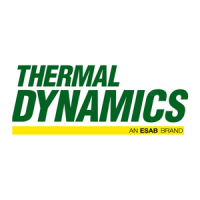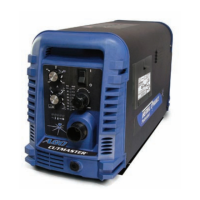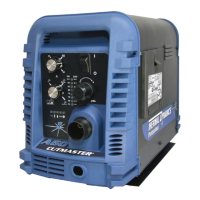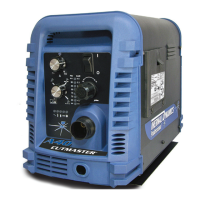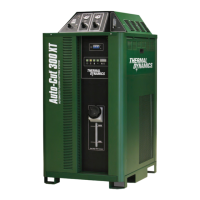A80
0-4985 INTRODUCTION
2T-3
By forcing the plasma gas and electric arc through a
small orice, the torch delivers a high concentration of
heat to a small area. The sti, constricted plasma arc is
shown in Zone C. Direct current (DC) straight polarity
is used for plasma cutting, as shown in the illustration.
Zone A channels a secondary gas that cools the torch.
This gas also assists the high velocity plasma gas in
blowing the molten metal out of the cut allowing for a
fast, slag - free cut.
B. Gas Distribution
The single gas used is internally split into plasma and
secondary gases.
The plasma gas ows into the torch through the nega-
tive lead, through the starter cartridge, around the elec-
trode, and out through the tip orice.
The secondary gas ows down around the outside of
the torch starter cartridge, and out between the tip and
shield cup around the plasma arc.
C. Pilot Arc
When the torch is started a pilot arc is established
between the electrode and cutting tip. This pilot arc
creates a path for the main arc to transfer to the work.
D. Main Cutting Arc
DC power is also used for the main cutting arc. The
negative output is connected to the torch electrode
through the torch lead. The positive output is con-
nected to the workpiece via the work cable and to the
torch through a pilot wire.
E. Parts - In - Place (PIP)
The torch includes a 'Parts - In - Place' (PIP) circuit. When
the shield cup is properly installed, it closes a switch. The
torch will not operate if this switch is open.
PIP Sw itch
Sh ield C
o ATC
CNC Start
PIP Sw itch
Sh ield C
PIP Sw itch
Sh ield C
Automation Torch
To ATC
o ATC
Art # A-08168
Parts - In - Place Circuit Diagram for Machine Torch
A-02997
Torch Trigger
PIP Switch
Shield Cup
To Control
Cable Wiring
Torch Switch
Parts - In - Place Circuit Diagram for Hand Torch
